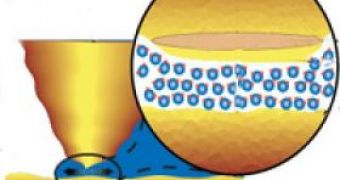Everybody knows water is essential to all known forms of life, or that it covers almost three quarters of Earth's surface. It is found mostly in liquid state, but the other states, solid (ice) and gaseous (vapor), and their behavior were also well known to scientists.
Well, it seems we didn't know everything about water, after all. A Georgia Tech research team has discovered that water exhibits very different properties when it is confined to channels less than two nanometers wide - behaving much like a viscous fluid with a viscosity approaching that of molasses.
Molasses or treacle is a thick syrup by-product from the processing of the sugarcane or sugar beet into sugar, exhibiting high viscosity, much like honey (The word molasses comes from the Portuguese word mela?o, which is in turn the Greek mellas - honey).
Although water has some unusual characteristics, this new one was surprisingly unforeseen. For instance, when most substances are compressed into a solid, their density increases. But water is different; when it becomes ice, it becomes less dense, and that's why many scientists reasoned that when water is compressed (as it is in a nanometer-sized channel), it should maintain its liquid properties and shouldn't exhibit properties that are akin to a solid.
Several earlier studies came to that very conclusion - that water confined in a nano-space behaves just like water does in the macro world. Consequently, a number of scientists considered the case to be closed.
Georgia Tech experimental physicist Elisa Riedo and her team where puzzled by the results of some new measurements, when they directly measured the force of pure water in a nanometer-sized channel, and found evidence suggesting that water was organized into layers. Riedo conducted these measurements by recording the force placed on a silicon tip of an atomic force microscope as it compressed water. The water was confined in a nanoscale thin film on top of a solid surface.
"Since water usually has a low viscosity, the force you would expect to feel as you compress it should be very small," said Riedo, assistant professor in Georgia Tech's School of Physics. "But when we did the experiment, we found that when the distance between the tip and the surface is about one nanometer, we feel a repulsive force by the water that is much stronger than what we would expect."
As the tip compresses the water even more, the repulsive force oscillates, indicating that the water molecules are forming layers. As the tip continues to increase its pressure on a layer, the layer collapses and the water flows out horizontally.
"In effect, the confined water film behaves effectively like a solid in the vertical direction by forming layers parallel to the confining tip and surface, while maintaining it's liquidity in the horizontal direction where it can flow out - resembling some phases of liquid crystals," said Uzi Landman, director of the Center for Computational Materials Science, Regents' and Institute professor, and Callaway Chair of Physics at Georgia Tech.
Then why did these new measurements exhibit such a contradiction?
It seems that the specific conditions or the experiment led to the new find. They found that when water was placed on a hydrophilic surface, the viscosity began to increase dramatically as the thickness of the confined film reached the 1.5 nanometer range. As they continued to compress the water and measure the lateral forces, the viscosity increased by a factor of 1,000 to 10,000. On hydrophobic surfaces, they did not see such an increase in viscosity. The results of the molecular dynamics simulations support these findings, showing a dramatically decreased mobility for sub-nanometer thick water films under hydrophilic confinement.
Understanding the properties of water at this scale could be important for biological and pharmaceutical research and applications, especially in understanding processes that depend on hydrated ionic transport through nanoscale channels and pores.

 14 DAY TRIAL //
14 DAY TRIAL //